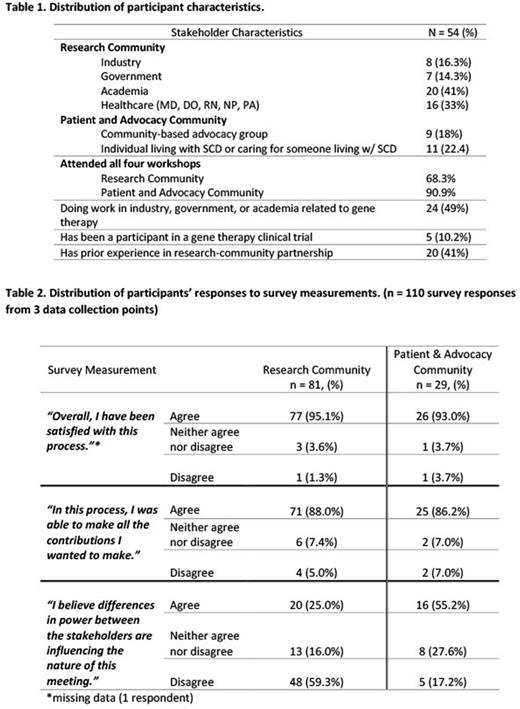Abstract
Background: While the advancement of genetic therapy for hematological disorders provides tremendous therapeutic promise, it is not without risk. Sickle cell disease (SCD) is at the forefront of the development of novel, genetic therapies. The process of engaging individuals living with SCD to participate in gene therapy clinical trials requires building trust, respect, and partnership with the community, given the history of neglect towards this disease. With the growth of sickle cell disease gene therapy clinical trials and potential of FDA approval for gene therapy treatments, there is a need for understandable, accessible, and actionable patient education materials (PEMs) that are not sponsored by a specific clinical trial. An objective of the Democratizing Knowledge for Sickle Cell Disease Gene Therapy Project was to examine the process of engaging a diverse group of stakeholders representing different interests within the SCD community to develop open-source patient education materials for sickle cell disease gene therapy.
Methods: For this project, we used a community-based dialogue model which incorporates participatory democracy with community based public health engagement approaches (Bonham et al PMID: 19451407). This approach was used to engage a multi-disciplinary group of patients, representatives of SCD advocacy groups, hematologists, gene therapy researchers, and industry and government stakeholders to purposefully work in teams over four workshops to create PEMs. Throughout this process, we recorded their deliberations, and collected survey data at three distinct stages of engagement.
Results: We dichotomized the data on experiences and engagement levels into two categories: the Research Community, which includes individuals representing industry, research, government, healthcare, academia, and the Patient and Advocacy Community, which includes individuals living with SCD, parents of children with SCD, and individuals representing community-based SCD advocacy groups.
Analysis of this longitudinal data from the three distinct points in time identified patterns across the stakeholder groups represented in these workshops. Of the participants in the research community, 68.3% attended all four workshops, while of those in the patient and advocacy community, 90.9% attended all four workshops (Table 1). In the research community, 95.1% expressed feeling satisfied with their participation in these workshops, and similarly, in the patient and advocacy community, 93.0% expressed feeling satisfied with their participation (Table 2). However, when surveyed about views on the role of power dynamics in this process, there were differing sentiments between these two groups. Amongst the research community, the majority felt power dynamics did not influence the workshops (59.3%). In contrast, amongst the patient and advocacy community, the majority felt power dynamics did influence the workshops (55.2%) (Table 2). In addition to this survey data, further data regarding the patient educational materials themselves and their dissemination will be reported.
Conclusion: The data highlights differential engagement regarding the level of participation between the different stakeholders within the SCD community. It also reflects both similarities and differences with respect to satisfaction and perception of power dynamics in this process. With these results, we aim to introduce how a community-based dialogue approach can be used as a model for engagement for SCD clinical trials, for creation of stakeholder-informed patient education materials, and for other disease communities.
Disclosures
No relevant conflicts of interest to declare.
Author notes
Asterisk with author names denotes non-ASH members.


This feature is available to Subscribers Only
Sign In or Create an Account Close Modal